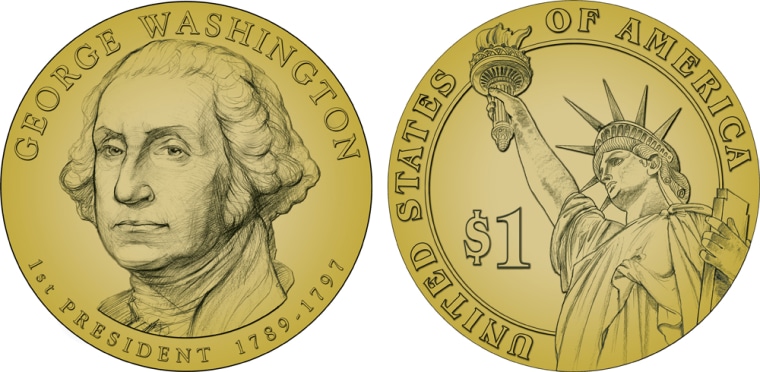Can George Washington and Thomas Jefferson succeed where Susan B. Anthony and Sacajawea failed? The U.S. Mint is hoping America's presidents will win acceptance, finally, for the maligned dollar coin.
The public will get the chance to decide starting in February when the first of the new coins, bearing the image of the first president, is introduced.
Washington, John Adams, Thomas Jefferson and James Madison are scheduled to grace the coin in 2007, with a different president appearing every three months.
The series will honor four different presidents per year, in the order they served in office. Each president will appear on only one coin, except for Grover Cleveland, who will be on two because he was the only president to serve nonconsecutive terms. To be depicted on a coin, a president must have been dead for at least two years.
The idea of rotating designs borrows from the highly successful 50-state quarter program. Since its launch in 1999, this program has featured five state designs each year in the order the state joined the union.
The quarter program has been widely successful, introducing millions of people to coin collecting for the first time. The Mint hopes the presidential program will enjoy similar success, in part because of the bold designs on the new coins.
Those designs were being made public during a ceremony Monday at the Smithsonian Institution's National Portrait Gallery, home of some of the famous paintings that served as models for the coins.
Copies of the designs were made available to The Associated Press in advance.
"These designs are beautiful and so eye-catching that a lot of Americans are going to do a double-take when they get them in their change the first time," Edmund C. Moy, the director of the Mint, said in an interview.
The coins will be the same size as the Sacagawea dollar — a little larger than a quarter — and the same golden color as the Sacagawea. The image of the president will be on one side and the Statue of Liberty on the other.
The images will be slightly larger than those on a quarter because space was freed by moving some of the traditional wording such as "In God We Trust" to the edge of the coin. Edge lettering has not been tried on an American coin since 1933.
Will all this be enough to make the presidential dollars a success where the Susan B. Anthony, introduced in 1979, and the Sacagawea, introduced in 2000, have been flops, at least in terms of gaining acceptance as circulating coins?
Moy is optimistic, saying a number of things have changed since the Sacagawea launch six years ago. Rising prices mean it takes more quarters to feed parking meters and vending machines. People might now be more willing to carry the dollar coin to replace four quarters.
Moy said the Mint also will do a better job of coordinating with the Federal Reserve to make sure commercial banks quickly get their orders filled for the new dollars.
"We are geared up to make hundreds of millions of these coins depending on what the demand is," Moy said.
Rep. Michael Castle, R-Del., a prime mover in Congress for both the 50-state quarter legislation and the presidential coins, said he believed the new dollars would have a good chance for success.
While the government would save about $500 million annually in printing costs if it got rid of the dollar bill in favor of more durable coins, Castle said there are no plans to follow the lead of Canada and several European countries in ditching the smaller currencies.
"The dollar bill is just Americana. There is a lot of sentiment to keeping it," he said.
